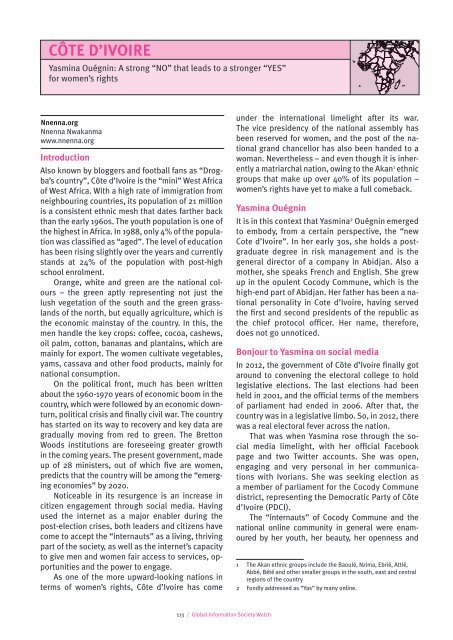gisw13_chapters
gisw13_chapters
gisw13_chapters
Create successful ePaper yourself
Turn your PDF publications into a flip-book with our unique Google optimized e-Paper software.
côte d’ivoireYasmina Ouégnin: A strong “NO” that leads to a stronger “YES”for women’s rightsNnenna.orgNnenna Nwakanmawww.nnenna.orgIntroductionAlso known by bloggers and football fans as “Drogba’scountry”, Côte d’Ivoire is the “mini” West Africaof West Africa. With a high rate of immigration fromneighbouring countries, its population of 21 millionis a consistent ethnic mesh that dates farther backthan the early 1960s. The youth population is one ofthe highest in Africa. In 1988, only 4% of the populationwas classified as “aged”. The level of educationhas been rising slightly over the years and currentlystands at 24% of the population with post-highschool enrolment.Orange, white and green are the national colours– the green aptly representing not just thelush vegetation of the south and the green grasslandsof the north, but equally agriculture, which isthe economic mainstay of the country. In this, themen handle the key crops: coffee, cocoa, cashews,oil palm, cotton, bananas and plantains, which aremainly for export. The women cultivate vegetables,yams, cassava and other food products, mainly fornational consumption.On the political front, much has been writtenabout the 1960-1970 years of economic boom in thecountry, which were followed by an economic downturn,political crisis and finally civil war. The countryhas started on its way to recovery and key data aregradually moving from red to green. The BrettonWoods institutions are foreseeing greater growthin the coming years. The present government, madeup of 28 ministers, out of which five are women,predicts that the country will be among the “emergingeconomies” by 2020.Noticeable in its resurgence is an increase incitizen engagement through social media. Havingused the internet as a major enabler during thepost-election crises, both leaders and citizens havecome to accept the “internauts” as a living, thrivingpart of the society, as well as the internet’s capacityto give men and women fair access to services, opportunitiesand the power to engage.As one of the more upward-looking nations interms of women’s rights, Côte d’Ivoire has comeunder the international limelight after its war.The vice presidency of the national assembly hasbeen reserved for women, and the post of the nationalgrand chancellor has also been handed to awoman. Nevertheless – and even though it is inherentlya matriarchal nation, owing to the Akan 1 ethnicgroups that make up over 40% of its population –women’s rights have yet to make a full comeback.Yasmina OuégninIt is in this context that Yasmina 2 Ouégnin emergedto embody, from a certain perspective, the “newCote d’Ivoire”. In her early 30s, she holds a postgraduatedegree in risk management and is thegeneral director of a company in Abidjan. Also amother, she speaks French and English. She grewup in the opulent Cocody Commune, which is thehigh-end part of Abidjan. Her father has been a nationalpersonality in Cote d’Ivoire, having servedthe first and second presidents of the republic asthe chief protocol officer. Her name, therefore,does not go unnoticed.Bonjour to Yasmina on social mediaIn 2012, the government of Côte d’Ivoire finally gotaround to convening the electoral college to holdlegislative elections. The last elections had beenheld in 2001, and the official terms of the membersof parliament had ended in 2006. After that, thecountry was in a legislative limbo. So, in 2012, therewas a real electoral fever across the nation.That was when Yasmina rose through the socialmedia limelight, with her official Facebookpage and two Twitter accounts. She was open,engaging and very personal in her communicationswith Ivorians. She was seeking election asa member of parliament for the Cocody Communedistrict, representing the Democratic Party of Côted’Ivoire (PDCI).The “internauts” of Cocody Commune and thenational online community in general were enamouredby her youth, her beauty, her openness and1 The Akan ethnic groups include the Baoulé, Nzima, Ebrié, Attié,Abbé, Bété and other smaller groups in the south, east and centralregions of the country2 Fondly addressed as “Yas” by many online.113 / Global Information Society Watch


